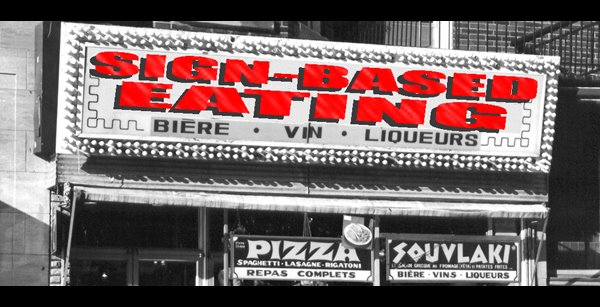
2051 Rosemont Blvd., 3 blocks east of Papineau, Montreal
Actual transcription of a phone message about the Capri Deli: “Hey John, got your message from last night. Unfortunately, got in really late and I’m sorry I didn’t call back. I wanted to tell you about, uh, a few places that I saw this week that I… I wanna check out. And I just left Dave a message on these. Every time I drive over to your place, uh, on Rosemont, I see the Capri Delicatessen... and it looks really good. It has an old sign at the front. It has lots of neon signs in the windows and it’s very narrow. Uh, you have the bar... well, the counter... and then a row of stools of course, that belong to the counter, and then a narrow passageway and then a row of booths, and that’s it. So, it’s the most ideal diner design, uh, you know, ever. Compact, efficient, and it has everything there. And people sit there, compressed against the glass, and there’re neon signs over their heads… and it looks so good, I just want to check that out. So, if you’re into that, I proposed to Dave to come over to my place Friday night, just before we head out, get a couple of drinks at my place and then, uh, head out to the Capri Delicatessen. So, that’s the plan that I’d like to, uh, try to… try to do.”
The one that started it all: Needless to say, the plan was carried out and the Capri Delicatessen became the place that planted the seed of the idea for Sign-Based Eating. After having eaten at the Capri just once, it was decided: places like these need to be documented in some way.
Backlit plastic: The sign is, unfortunately, not what it used to be when it first caught our eye. Sure the basic structure is still there but most of the neon – the letters spelling out C-a-p-r-i and all the rest – has been replaced by ugly yellow and orange backlit plastic.
Back for more: What is it that made me return to the Capri Deli on more than one occasion? The wonderfully flat and oily grilled cheese sandwiches? The dour waitress who became abusive when we politely requested to be moved to a larger booth? Or the absurdity of being able to order Chinese food in what is essentially a hot dog and poutine joint (that is until we peeked through the serving window and noticed that the short-order cook was, in fact, Asian)?
Thought about: Whenever I see the sign now, it makes me lament all of the places I’ve failed to visit before the neon fizzled out and the blinking bulbs flashed their last flicker of incandescence…







